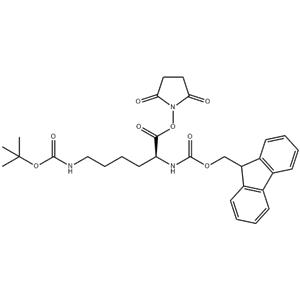Peptide Synthesis: Fmoc-Lys(Boc)-OSu serves as a crucial reagent in solid-phase peptide synthesis. It enables the stepwise addition of amino acid units to elongate peptide chains, allowing researchers to synthesize peptides with specific sequences and functions. This synthetic technique is pivotal for the preparation of bioactive peptides, drug candidates, and the study of protein structure and function.
Protein Engineering: In the field of protein engineering, Fmoc-Lys(Boc)-OSu can be used to introduce specific amino acid modifications or tags to proteins. These modifications can alter the properties, functions, or stability of proteins, enabling precise regulation of protein function. Drug Design and Development: Due to its excellent reactivity and selectivity, Fmoc-Lys(Boc)-OSu is often utilized in the design and synthesis of potential drug candidates. By adjusting the peptide sequence and structure, researchers can develop drugs with specific biological activities for the treatment of various diseases. Biological Probing and Imaging: Leveraging the fluorescent or labeling properties of Fmoc-Lys(Boc)-OSu, it can be employed as a biological probe for detecting or imaging specific molecules or cells within biological systems. This capability is significant for studying biological processes, disease mechanisms, and drug action mechanisms. Biomaterial Preparation: Additionally, Fmoc-Lys(Boc)-OSu can be used in the preparation of functional biomaterials. By adjusting its chemical structure and reaction conditions, materials with excellent biocompatibility, stability, and mechanical properties can be fabricated, finding applications in tissue engineering, regenerative medicine, and biosensors. | 

 China
China

